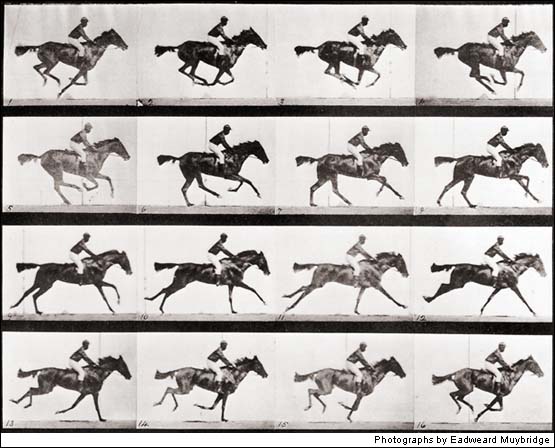Muybridge and his influence on the
world of art
Eadweard Muybrige, born in England in 1830, has had a
profound effect on the world of photography, cinematography and the art world
in general. Although most famed for his
images of moving horses, he had already achieved recognition through his
landscape photography and as a war photographer following his move to America
in 1852. His progression towards motion
photography was fuelled by the whim of a wealthy railroad baron and passionate
race horse breeder, who was trying to win a bet to prove that a horse lifted
all four feet off the ground when it galloped.
Muybrige’s first success was to capture a picture of a horse at trot,
but by 1878 he had designed his own high speed electronic shutter and electro
timer, to be used in conjunction with 24 cameras in an attempt to record one of
Stanford’s thoroughbreds at a gallop.
The cameras were triggered in sequence, four every second as the horse
galloped past and finally the gait of a horse was captured in images. Suddenly photography had gone beyond
‘freezing the moment,’ for the first time enabling human beings to see
something faster than their own eyes in a series of photographic images. Muybrige immediately saw the potential of
this and began to create an encyclopaedia of motion that is still widely used
today as a study of movement and the human form.
At the same time, many artists were becoming increasingly
aware of photographic developments but it was shunned by some as an art form
for failed painters. The impressionist
movement was well under way and Degas was one artist who took a different view.
He embraced the medium and its
possibilities and began to explore it further, predominantly with a view to
enhancing his studies of ballerinas in movement. His interest was sparked initially as he
began collecting ‘cartes de visite’, particularly those showing ballerinas in a
variety of poses. But he was an
experimental artist, keen to explore technological developments and soon he was
drawn towards Muybrige’s experiments with the moving image. Degas became increasingly preoccupied with
capturing movement accurately within his paintings, as well as beginning to
experiment with composition, representing a series of figures in frieze style
paintings, following Muybrige’s invention of working in series. Last year’s exhibition at the Royal academy –
“Degas and the Ballet -picturing movement” paid homage to the work of Muybrige
and his influence on the development of Degas’ work. Degas was so enamoured that he eventually
took up photography himself and his camera became one of his most prized
possessions.
Muybrige’s studies not only helped influence art at the time
but he also paved the way to the development of the motion picture with his
invention the zoopraxiscope. This device
enabled him to animate sequences from his motion studies. Muybrige existed in a progressive time and he
himself embraced opportunities for innovation.
He invented photographic and moving image projection techniques that
have helped to underpin the motion picture industry of today. His influence on the world of art was
enormous, enabling artists to represent figures in movement in a realistic way
that had previously evaded them. A true
entrepreneur, visionary and moderniser, respected in his own time and beyond, he
has earned his place as one of the world’s most influential photographers.



No comments:
Post a Comment